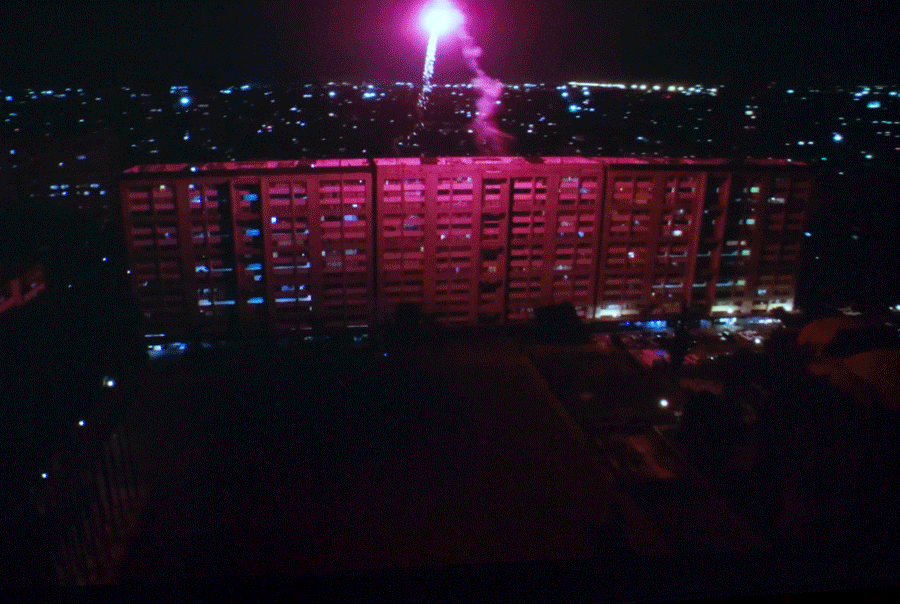Today Was Another Sunny Day
June 7–September 18, 2016
CRÓTALOS
Façade project
June 7–September 18, 2016
Savage Sunday
May 21–October 2, 2016
Sala de Arte Público Siqueiros
Fernando Sánchez Castillo
Hoy también fue un día soleado (Today was Another Sunny Day)
Sánchez Castillo develops—often with humor—a radical critique of the monumental discourse in which he disarticulates its agencies of power and representation. His deconstruction of monuments is a means to look into the contradictions of History by subverting the portrayals and manipulations of official narratives and demystifying its canons, heroes, discourses, and established truths. In this exhibition, the artist deals with the tragic events that took place in Tlatelolco on October 2, 1968.
The works in the show are based on his investigation into all forms of resource material relating to the massacre—documents, photographs, videos, and archives—and on the artistic re-representation and reenactment of some of this existing material. There are three pieces in the exhibition. The first, a colossal statue of an anonymous student whose image was borrowed from a photograph of the events that documents how the protestors were forced by the military to pull their pants down in order to show they weren’t armed. In it, the artist monumentalizes a defenseless victim that has been coerced into an embarrassing position instead of elevating a leader to glory through victorious poses. During the duration of the show, Oaxacan artisan Alberto Ruíz will be weaving a large tapestry on a traditional loom that shows a map of the Plaza de las Tres Culturas where the location of the snipers and the direction of their shots are depicted. The snipers were discovered to be government officials working within the Presidential General Staff who acted out a secret operation—woven from the highest levels– driven to provoke the army to violently reprehend the students. The third piece is a video that shows the flight of a drone over Tlatelolco. It illustrates a luminous action in the Plaza made with green and red flares, imitating the pyrotechnics that signaled the start of military action in 1968 and it culminates with a white light that makes up the symbolic composition of the Mexican flag; a posthumous homage. Curated by Gerardo Mosquera, guest curator.
The façade project, CRÓTALOS by Ramiro Chaves, is part of the artist’s extensive research related to the phenomenology—dating back to pre-Hispanic times and until today—surrounding the use of the X in Mexican language, architecture, and symbolism. His investigation on the subject has been manifested in media ranging from web-based projects to poetry. Each iteration or new phase of his involvement with the symbol accentuates its own recurrence in Mexican culture. For the façade project, Chaves extends his insistent inquiry now to the format of the public mural, which he made borrowing images from the work of three figures involved with the public realm: José Díaz Bolio, Manuel Amabilis and Adolfo Best Maugard. Chaves generates, by the materials and the iconography he employs, a dialogue with Mexican history of “the public” throughout times. Curated by Michele Fiedler, curator at SAPS.
La Tallera
Pedro Reyes: Domingo Salvaje (Savage Sunday)
Savage Sunday generates a nodal structure in which multiple investigations coalesce into a discursive core that constitutes an ontological construction of the study of psychopharmacology, considered both as a universal tradition spanning all world cultures and within the context of Mexico’s history in particular. The approach taken by the artist takes as its basis an analysis of Greek Philosophy through historical figures like Aristophanes, Aristotle, Epicurus and Plato. Disciplines such as ethnology and anthropology have led him through the research of various past cultural projects that saw Mexico as the ideal place to unfold community-scale undertakings, making towns like Cuernavaca and Zihuatanejo spaces for social experiments that continue to influence utopian viewpoints on society.
The exhibition lies at the junction of literature, architecture, philosophy, and sound. The works comprise a sonic and visual exercise that Reyes has posited in relation to pre-Hispanic constructions and modern notions of power and express the artist’s insistence on living joy embodied in human form. Curated by Taiyana Pimentel, with Mariana Mañón, and Aleida Pardo.
About Proyecto Siqueiros
A joint endeavor of Sala de Arte Público Siqueiros (SAPS) in Mexico City and La Tallera in Cuernavaca, Morelos, Proyecto Siqueiros is a platform for national and international contemporary art designed as a space for critical reviewing while preserving and promoting the artworks held by both venues. Launched in 2010, the project seeks to articulate reflective proposals regarding the theoretical and artistic precepts set forth by Mexican muralist David Alfaro Siqueiros; attending to the public nature of art and its social and political commitments, alongside his ever present search for experimental languages and materials.
Sala de Arte Público Siqueiros
Tres Picos 29
Colonia Polanco
México City
México
La Tallera
Calle Venus 52
Jardines de Cuernava
Frente a Parque Siqueiros
CP 62360
Cuernavaca, Morelos
México

